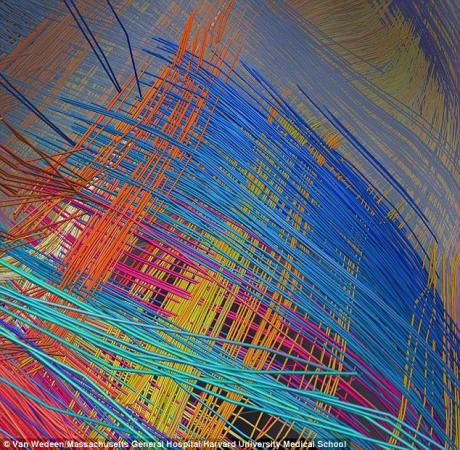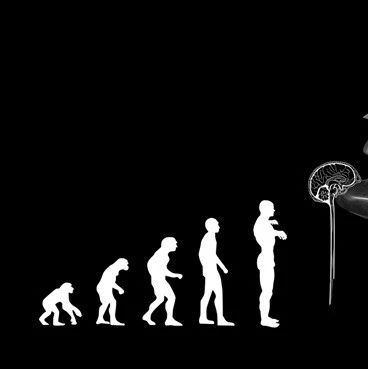导读:很久以来,人们认为大脑是一团缠绕的神经纤维,但研究人员最近发现,脑中的神经纤维呈十字交叉,就像一个棋盘一样。如果神经元能够转向4个方向:左、右、向上或向下,一种更为高效、有序的方式会被启用,从而有利于神经纤维找到适合的串接,以及大脑结构不断适应进化。

平行的神经纤维往右倾斜形成交叉路径,进而形成2维折叠的神经层面

猴子大脑中神经纤维的3维串接图
很久以来,人们认为大脑是一团缠绕的神经纤维,但研究人员最近发现,脑中的神经纤维呈十字交叉,就像一个棋盘一样。如今,一些精妙细节作为大脑成像研究的一部分揭示了大脑的网络结构,它们借助于新的磁共振成像(MRI)扫描仪。研究结果发表在《科学》Science 期刊上。
马萨诸塞州总医院(MGH)Van Wedeen领导这项研究,他说:“ 而非一团神经纤维,大脑中的神经串接更像是带状光缆。像织布中的经、纬线一样,平行的神经纤维往右倾斜形成交叉路径,进而形成2维折叠的神经层面。这一网络结构在任何区域都是连续、一致的,不只是人类,其它灵长类动物也是如此。”
Thomas R Insel是国家心理健康研究所National Institute for Mental Health的主任,他说:“获取高分辨率的大脑串接图是人类神经解剖学上的一个里程碑,该新技术可解释个体大脑的串接差异,因而有助于诊断和治疗脑部疾病。”
据Wedeen 称:“Connectom核磁共振成像扫描仪去年安装在麻省总医院,相比于常规扫描仪,这一新设备在分辨率上提高了10倍,可观测到纵横交错的神经纤维。”
他还说:“这一设备让我们更敏锐地观察到惊人的简单结构,从而解释大脑如何发育。成熟大脑的串接结构看似能反映胚胎发育过程中的2个原始途径。在大脑发育的早期,神经纤维串接后形成直线路径,表现出水平、垂直与交叉的形式。”
像高速路上的路标一样,这个网络结构看似能够引导神经纤维串接,在发育期间,它能够限制关于神经纤维改变方向的选择。
研究人员称:“如果神经元能够转向4个方向:左、右、向上或向下,一种更为高效、有序的方式会被启用,从而有利于神经纤维找到适合的串接,以及大脑结构不断适应进化。”
长期以来,研究人员没有能明白人类大脑的详细图像,部分原因是大脑皮层形成许多皱褶,上面的角落和缝隙掩盖了大脑的串接结构。
尽管以往的研究借助动物大脑中的化学示踪剂显示神经网络结构,但是这种侵害性技术不能用于人类。之前的技术只能揭示25%的大脑结构,而新扫描仪拍摄的结构占到75%。

 Segregation and Wiring in the Brain
Segregation and Wiring in the Brain
Karl Zilles,Katrin Amunts
A mosaic of hundreds of interconnected and microscopically identifiable areas in the human cerebral cortex controls cognition, perception, and behavior. Each area covers up to 40 cm2 of the cortical surface and consists of up to 750 million nerve cells (1). The architecture—the spatial distribution, density, size, and shape of nerve cells and their processes—varies between different cortical areas. Nerve cells are interconnected within each area and with other brain regions and the spinal cord via fiber tracts, synapses, transmitters, modulators, and receptors. This incredible structural complexity underlies the functional segregation in the cerebral cortex. The ultimate goal—to understand the driving forces and organizational principles of the human brain beyond the cellular and functional details—remains a challenge. Reports by Chen et al. (2) and Wedeen et al. (3) on pages 1634 and 1628 of this issue, respectively, accept this challenge by analyzing the genetic topography of the cortex and the spatial course of fiber pathways in the brain. The studies find unifying hierarchical and geometric rules behind the organizational details.
文献链接:https://www.sciencemag.org/content/335/6076/1582.summary?sid=7d2462f4-f2e9-463a-8ea8-01eb7baf94ba







